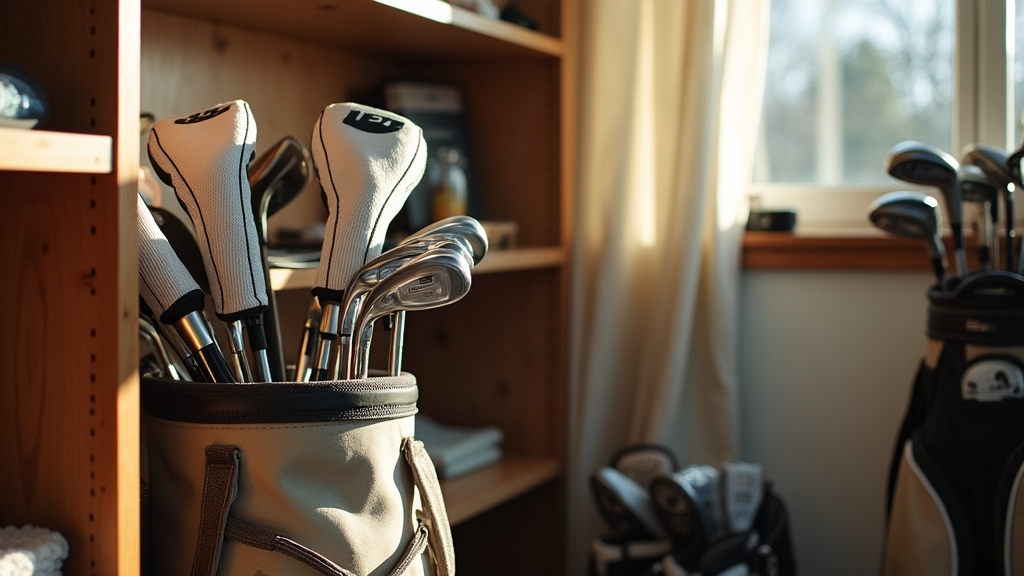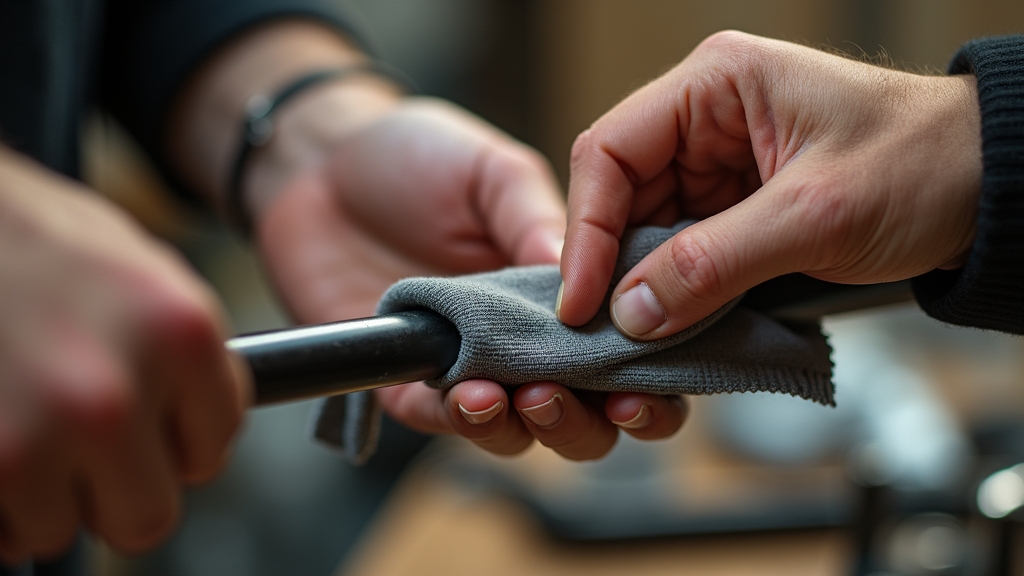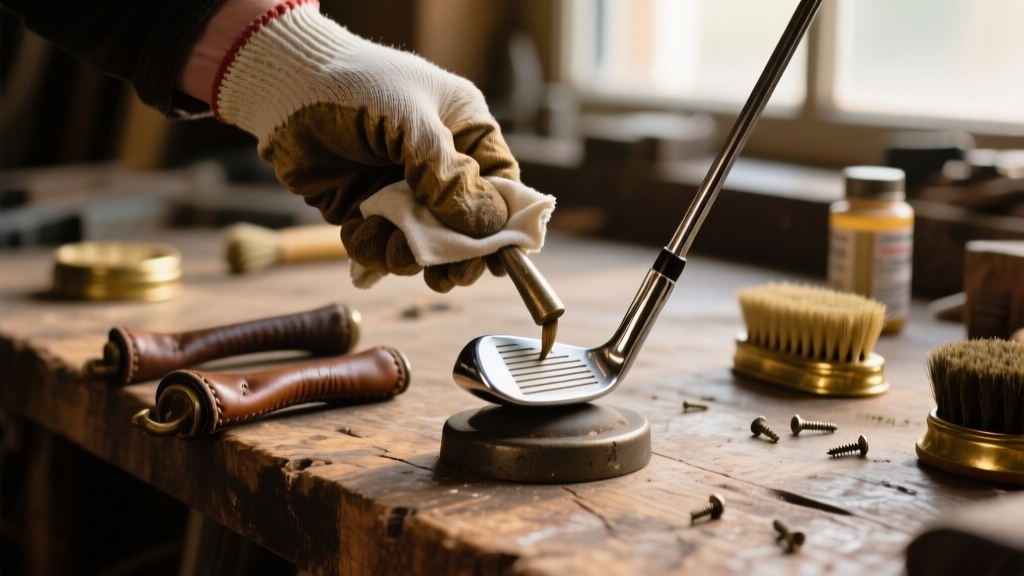You should clean your clubs after each round using lukewarm, soapy water and a soft brush to maintain grooves sharpness. This guarantees better shot control. Dry shafts and grips thoroughly to prevent rust and wear. Store clubs upright in a dry, climate-controlled space with headcovers to protect clubheads.
Regularly inspect grips for tackiness and replace as needed. Following these steps preserves performance and extends lifespan. Discover additional expert tips to keep your clubs in top condition and improve your game.
- Key Takeaways
- Proper Cleaning Techniques for Golf Clubs
- Importance of Maintaining Clubface Grooves
- Scheduling Routine Maintenance for Optimal Performance
- Best Practices for Storing Golf Clubs
- Caring for Shafts and Grips
- Identifying When Professional Maintenance Is Needed
- Tips for On-Course Club Care
- Frequently Asked Questions
- Sharpen Your Shots: Keep Your Clubs Swing-Ready Every Round
Key Takeaways
- Clean clubheads regularly using lukewarm soapy water and a soft brush, avoiding soaking metal woods and wooden clubs.
- Maintain groove sharpness with a specialized groove sharpener every 10–20 rounds to enhance shot control and spin.
- Dry shafts and grips thoroughly after each use, deep clean grips monthly, and replace them every 40–50 rounds or 6–18 months.
- Store clubs upright in a dry, climate-controlled environment using headcovers to prevent rust, dents, and heat damage.
- Clean shafts with mild soap and a damp cloth; treat steel shafts with steel wool for rust and keep grips tacky for optimal performance.
Proper Cleaning Techniques for Golf Clubs
When you clean your golf clubs properly, you guarantee their peak performance and extend their lifespan. Start by filling a bucket with lukewarm water mixed with gentle dish soap. Soak irons and wedges for about 10 minutes to loosen dirt. Use a soft-bristled nylon brush to scrub the clubface, sole, and back, avoiding the grooves.
Rinse carefully under running water, steering clear of ferrules and shafts. Immediately dry each club with a microfiber cloth to prevent rust. For metal woods, avoid full submersion; instead, wipe with a damp cloth dipped in soapy water and dry thoroughly.
Wooden clubs require delicate wiping with a damp cloth—no scrubbing or soaking—to protect the finish. Always use absorbent towels to dry shafts and grips after cleaning to maintain ideal condition. Regular inspection of grips for signs of wear ensures they maintain optimal traction and performance.
Importance of Maintaining Clubface Grooves
Hey there! Let’s talk about the importance of keeping those clubface grooves in tip-top shape. You really should make it a habit to clean your clubface grooves regularly. A soft brass or plastic brush works wonders when you add a little water—just enough to remove the dirt without risking any damage to those important edges.
Now, why is this so crucial? Well, maintaining sharp and deep grooves is all about improving your friction on the ball. This directly enhances your backspin and shot control, which we all know can make a huge difference on the course.
Plus, if you consistently sharpen those grooves, you’ll preserve their effectiveness. And who doesn’t want reliable performance when they’re aiming for better scores? Also, just like maintaining grooves, regular cleaning and proper care of your golf grips, including occasional light sanding with fine-grit sandpaper, helps ensure optimal performance and control.
Groove Cleaning Techniques
Why does maintaining clean grooves on your golf clubs matter? Clean grooves clear away grass, dirt, sand, and moisture that reduce friction at impact. Carrying your clubs with proper bag organization helps prevent damage to grooves during transport.
To clean, soak your clubs in warm water with mild detergent to loosen debris. Then, use a brass or plastic wire brush to carefully remove residue without damaging grooves. Using a bucket of Oxiclean is an effective way to soak clubs gently and loosen grime without harming materials.
After brushing, dry grooves thoroughly to prevent rust or corrosion, especially on irons. During rounds, wipe grooves with a wet towel and mild soap after shots to maintain cleanliness. Regular cleaning preserves groove sharpness, ensuring consistent ball-to-clubface contact and predictable performance.
Avoid submerging wooden or metal-wood clubs; use a damp cloth instead. Proper groove maintenance extends club life and supports reliable play across course conditions.
Impact on Ball Spin
How exactly do grooves on your golf clubs influence ball spin? Grooves increase friction by channeling away moisture, dirt, and grass. This allows the sharp edges to grip the ball and generate vital backspin. Moreover, effective debris removal by grooves is crucial in challenging lies like wet or thick grass.
This spin stabilizes ball flight and improves control, especially on short shots. Dirty or worn grooves reduce friction, causing the ball to slip and lowering spin rates considerably.
| Groove Condition | Impact on Spin | Resulting Control |
|---|---|---|
| Clean & Sharp | High friction | Precise stopping power |
| Dirty & Clogged | Reduced friction | Lower backspin, less control |
| Worn & Smooth | Minimal friction | Unpredictable ball flight |
Maintaining clean, sharp grooves ensures consistent spin. This enables you to shape shots and control stopping distance effectively.
Groove Sharpening Benefits
Grooves play a vital role in generating ball spin, but their effectiveness diminishes as edges wear down from use and exposure. When grooves lose sharpness due to dirt, rust, or grass buildup, they can’t grip the ball effectively, reducing friction and control. The Caddy Splash Golf Club Groove Sharpener is designed to provide a pro-level performance regrooving solution that is both durable and portable.
You should use a specialized groove sharpener aligned carefully with the groove pattern to restore crisp edges without damaging the clubface. This process channels debris and moisture away during impact, improving shot consistency, trajectory control, and stopping power on greens. Just as securing equipment properly is essential when hauling golf carts, precision and care are equally important in groove maintenance.
Regular sharpening every 10–20 rounds maintains the club’s original performance, delays costly replacements, and keeps you compliant with USGA regulations. Avoid excessive pressure or improper tools to prevent illegal groove alterations. Incorporate groove maintenance into your routine to optimize short game precision and extend your clubs’ functional life.
Scheduling Routine Maintenance for Optimal Performance
Although routine maintenance may seem time-consuming, scheduling it systematically guarantees your golf clubs perform consistently at their best.
After every round, inspect and clean clubheads to remove debris affecting ball contact. Wipe shafts and grips to eliminate oils and sweat, drying components thoroughly. Regular equipment maintenance, including daily inspections, helps prolong the lifespan of club assets. Measuring the wrist to floor height can also inform adjustments needed for club length during maintenance.
Perform detailed cleaning weekly or biweekly, focusing on grooves and grips. Deep clean grips monthly and replace them every 40–50 rounds or 6–18 months based on wear. Sharpen grooves and lubricate adjustable parts regularly. Inspect shafts monthly for damage, especially after transport.
Schedule professional maintenance annually or sooner if you play frequently or compete, ensuring shaft integrity, re-grooving, and proper alignment. Adjust maintenance frequency for environmental factors like humidity or sand to prevent accelerated wear and maintain ideal performance.
Best Practices for Storing Golf Clubs

When it comes to storing your golf clubs, keeping them in a dry environment is key. This helps to prevent rust and keeps the grips from deteriorating. You definitely don’t want to deal with that! Choosing grips made from durable materials can also extend the life of your clubs during storage.
Also, using headcovers is a smart move. They protect your clubheads from scratches and dents, whether you’re just storing them or transporting them to the golf course. Trust me, those little covers can save you a lot of headaches down the line.
And here’s a tip: try to avoid exposing your clubs to heat or extreme temperatures. Over time, this can warp the shafts and degrade the materials. Additionally, storing your clubs in a location with good air circulation helps maintain their condition and prolongs their lifespan.
Dry Environment Importance
When storing golf clubs, maintaining a dry environment is critical to prevent rust, corrosion, and grip degradation.
First, always clean and dry your clubs thoroughly after each use. Moisture left on shafts or heads accelerates rust formation. Use a golf club-specific cleaner like Club Doctor – Golf Club Cleaner to remove dirt, grass, and moisture effectively, which helps to prevent corrosion.
Store clubs in climate-controlled areas with stable temperature and humidity to avoid metal corrosion and grip damage. Avoid basements, attics, and car trunks. Keeping clubs in a controlled environment also helps preserve the durability of steel construction.
Use silica gel packets inside your golf bag to absorb excess moisture. Ensure good air circulation around clubs to prevent stagnant dampness. Position clubs upright in ventilated organizers or quality bags with individual slots to reduce moisture traps and physical damage.
Finally, consider light applications of mineral oil on clubheads to create a moisture barrier. Avoid over-oiling, as it attracts dust and grime, compromising the dryness you aim to uphold.
Use of Headcovers
Maintaining a dry environment for your golf clubs goes hand in hand with protecting them using quality headcovers. Always secure headcovers firmly on each club head to prevent scratches and dents during transport and storage.
Store them in a cool, dry, well-ventilated area, avoiding direct sunlight to prevent fading and warping. Hanging covers when possible to maintain shape and avoid creasing also helps prevent material damage. Proper storage also supports clubface alignment by preventing accidental impacts that could alter performance.
Clean leather covers with mild soap and conditioner to keep flexibility, while synthetic and knit materials require gentle washing. Inspect headcovers regularly for rips or loose stitching, repairing minor damage promptly to prevent deterioration.
Rotate headcovers between uses to distribute wear evenly, and replace any that are beyond repair. Utilize dedicated compartments or organizers to keep headcovers accessible and maintain their protective function.
Avoid Heat Exposure
Although golf clubs are designed for outdoor use, storing them in environments with stable, moderate temperatures between 50°F and 70°F (10°C to 21°C) is essential to prevent heat-induced warping and grip deterioration.
Avoid placing clubs in garages, attics, or car trunks where temperature swings are extreme. Use insulated closets or climate-controlled storage units to maintain consistent heat levels. Proper storage also helps maintain grip control which is crucial for reducing slicing tendencies.
Protect clubs with weatherproof, UV-resistant covers to minimize exposure to sunlight and heat. Never leave clubs inside vehicles parked in the sun, as internal temperatures can rise sharply.
Regularly inspect grips and shafts for signs of heat damage such as warping or fading. Elevate clubs off floors to avoid moisture and cold exposure. It is also important to store clubs upright to avoid bending or warping and to maintain their shape.
Following these measures will guarantee your clubs retain their structural integrity and performance over time.
Caring for Shafts and Grips

Because shafts and grips directly affect your control and performance, you need to clean and protect them carefully after every round. Wipe shafts with a damp cloth and mild soap, avoiding harsh chemicals. Use steel wool gently on steel shafts if rust appears. Proper maintenance also helps preserve the shaft’s durability and weight, which influence your swing feel.
Clean grips with a damp cloth, focusing on removing oils to maintain tackiness. Store clubs upright in cool, dry places, using headcovers and dividers to prevent damage. It is also important to regularly check grips for wear or looseness to maintain optimal swing mechanics.
| Component | Cleaning Method | Protection Tips |
|---|---|---|
| Steel Shaft | Damp cloth; mild soap; steel wool for rust | Apply car wax; avoid bending |
| Graphite Shaft | Soft cloth with water only | Use furniture wax; prevent scratches |
| Grips | Damp cloth; mild soap; rub firmly | Replace if worn; avoid harsh chemicals |
Identifying When Professional Maintenance Is Needed
When you notice reduced spin, inconsistent ball flight, or visible damage on your clubs, it’s time to contemplate professional maintenance. Inspect grooves closely; worn or dirt-clogged grooves diminish control and require re-grooving or replacement, especially on wedges every 1-3 years.
Check loft and lie angles annually. Shifts affect shot accuracy and need precise re-angling with professional tools. Incorporating a regular maintenance schedule ensures consistent performance and longevity of your clubs.
Examine shafts for dents, bends, or cracks. Any structural damage compromises safety and demands immediate expert attention. Assess grips for hardness, shine, or wear patterns causing slippage, signaling the need for re-gripping.
Monitor overall club performance. Irons beyond 7-10 years or drivers over 3-5 years may need professional evaluation. Timely maintenance preserves club geometry, performance, and safety. This ensures your equipment matches evolving swing dynamics and maximizes shot consistency.
Tips for On-Course Club Care
Proper maintenance extends beyond professional servicing and continues throughout your time on the course. After each shot, clean your clubheads with a soft-bristle brush and warm soapy water, focusing on grooves to remove dirt and grass.
Pat clubs dry immediately to prevent rust, especially in humid conditions. Use a groove cleaner after every stroke and sharpen grooves periodically to maintain spin control and shot accuracy. Wipe grips with a damp cloth and let them air dry to ensure a secure hold. Protect your clubs by using headcovers during transport and avoid rough handling to prevent shaft damage.
Follow course rules by hitting practice swings off turf and chipping only on designated greens to safeguard playing surfaces and prolong club life. Additionally, involving players in maintenance tasks like adhering to cart paths helps protect turf quality and reduces repair needs.
Frequently Asked Questions
How Do Weather Conditions Affect Golf Club Maintenance?
Weather impacts your golf club maintenance considerably. Heat makes shafts more flexible but accelerates material fatigue, so avoid prolonged exposure. Cold stiffens shafts and can cause brittleness, requiring careful indoor storage. Humidity affects grip texture; high moisture makes them slippery, while low dries them out.
Rain and wet conditions demand thorough drying to prevent rust. Wind deposits debris on your clubs, so clean them frequently. Adjust your maintenance routine based on these conditions to preserve performance and durability.
Can Homemade Cleaning Solutions Harm Golf Clubs?
You might unintentionally invite trouble by using homemade cleaning solutions on golf clubs. Hot water can weaken adhesives, while harsh chemicals strip protective coatings, risking corrosion.
Abrasive tools scratch surfaces, impairing performance. Soaking woods or hybrids leads to swelling or loosening parts. To protect your clubs, use mild soap with warm—not hot—water, soft brushes, and avoid submerging delicate components.
Thorough drying afterward prevents rust and preserves your investment’s longevity.
What Are the Signs of Over-Tightening Clubheads During Assembly?
You’ll notice visible cracks or micro-fractures around the hosel if you over-tighten clubheads. The ferrule might distort or crush, and threads inside the hosel can strip or bind.
You may experience difficulty seating the clubhead fully, excessive resistance during assembly, or tool slippage due to binding. Over-tightening can cause sudden looseness, unusual vibration, or changes in swing weight. These are clear signs you’ve exceeded torque specs and risk damaging your club.
How Should I Clean Vintage or Collectible Golf Clubs?
Think of cleaning vintage golf clubs as carefully restoring a delicate painting.
Start with a soft toothbrush to gently remove dirt, avoiding heavy water use to protect finishes. Use superfine 0000 steel wool on dry wood surfaces to smooth grime without harming the grain.
For iron heads, apply fine sandpaper or steel wool with light oil for rust. Always dry thoroughly, then protect wood with thin shellac coats to preserve their timeless beauty.
Are There Eco-Friendly Products Recommended for Golf Club Care?
Yes, you can use eco-friendly sprays like Clean Strike by Verta Golf, which cleans oils and rust instantly while supporting ocean plastic recycling. Careful Golf’s 4-in-1 Premium Foaming Cleaner offers a water-free, biodegradable option that’s gentle on equipment and the environment.
For professional cleaning, Club Clean Pro uses biodegradable solutions and solar-powered equipment. These eco-conscious products maintain your clubs effectively while minimizing environmental impact, so you can clean responsibly without sacrificing performance.
Sharpen Your Shots: Keep Your Clubs Swing-Ready Every Round
By regularly cleaning your golf clubs and maintaining the grooves like a craftsman sharpening tools, you guarantee each swing slices through the air with precision. Picture your clubs as finely tuned instruments; neglecting them dulls their edge.
Stick to scheduled maintenance, protect shafts and grips, and know when to seek professional care. This disciplined routine keeps your gear performing at its peak, ready to meet every challenge on the course with confidence and control.

